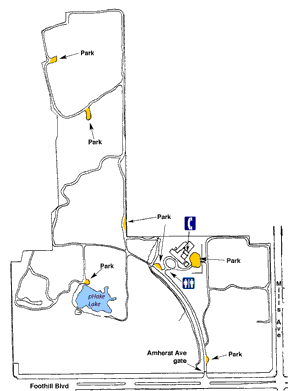HOME > Procedures > Student Rules
Rules for Student Use of the Bernard Field Station
The Bernard Field Station of the Claremont Colleges (BFS) is a common-use facility of the Claremont University Consortium, serving the teaching and research needs of students, faculty, and staff of all of the Colleges. It is used primarily as an outdoor laboratory for classes and research projects in biology and environmental science. It is a remarkable and fragile resource whose use must be fairly shared among all its users. Rules for its use are as follows:
- The BFS is not for casual and recreational use. In particular, the following are strictly prohibited:
- running or jogging
- recreational bicycling
- dogs
- fishing
- overnight use (except for approved research projects)
- Smoking and fires of any kind are prohibited without exception, at all times, on every part of the BFS.
- Students are not to drive cars to or on the BFS except to transport people with limited mobility or heavy or unwieldy equipment. Bicycles are permitted for transportation to your study site. Cars and bicycles must stay on dirt or paved roads within the BFS; driving on or through native vegetation is forbidden.
- If you must drive to transport equipment, park ONLY along Mills or Foothill or other designated areas. All roadways inside the BFS are firelanes, and they MUST be kept clear at all times so a fire truck can pass unhindered. Do not park in the circle in front of the old infirmary; the only fire hydrant on the BFS is there. Never park on native vegetation. Do not park on the paved area in front of the gate at any time.
- Enter the BFS by the gate at Amherst Ave on Foothill Blvd. The student combination lock is on the pedestrian gate. The current combination is _____________; your instructor will notify you if it changes. Be careful to:
- Re-lock the gate behind you after you enter the station and again after you leave.
- Note that the dials must be turned away from the combination to secure the lock.
- Make sure that the chain is around both halves of the gate when you lock it.
- Make sure that you do not bypass the other locks when you lock the student lock.
- Do not share the combination with others not in your class.
- For restrooms, use the Porta-Potty located near the circle in front of the old infirmary.
- Habitats within the BFS are fragile, so don’t go tromping through them. Stay on paved and fire roads whenever possible, and be very careful to step around, not on top of, bushes and other vegetation. (Note that poison oak is abundant on the BFS, so stepping on bushes can be its own punishment.)
- Do not modify vegetation or alter the BFS in any way unless it is a specifically approved part of your project. Refer to #8 above.
- Respect other people’s projects. If you see marking flags or other indications of studies, stay away and go around. Deliberately interfering with other projects is grossly unethical and will cause you to be banned from the BFS.
- All projects on the BFS require approval. To apply for BFS use, use the on-line use request form.
- The instructor will apply for class group projects. Individual projects within a class are normally covered by the class approval obtained by the instructor.
- Individual student research projects lasting a semester or longer must be approved on a case-by-case basis.
- Most projects are routinely approved by the Director within a few days; however, please note the exceptions below.
- Any projects involving collecting, habitat manipulation, or destruction or plants or animals must be approved by the Faculty Advisory Committee; please apply well advance of your start date.
- Projects that involve the use of vertebrate animals must be approved by your College’s Animal Care and Use Committee. Contact your instructor for information.
[printer-friendly map - use Page Setup to reduce if it doesn’t fit on one page]
Approved January 17, 2002
by the BFS Faculty Advisory Committee
© 2001-2012 Bernard Field Station Faculty Advisory Committee
Page last updated 6 September 2012 by Nancy Hamlett.

